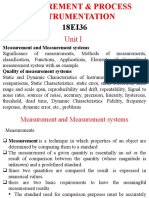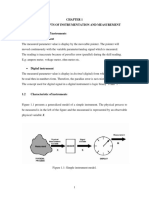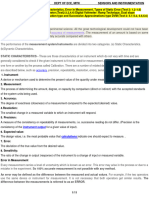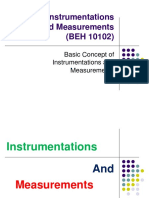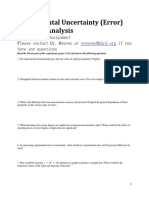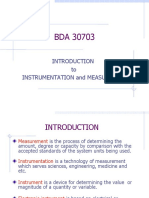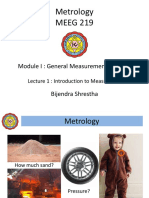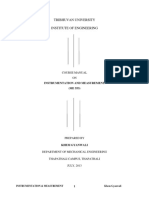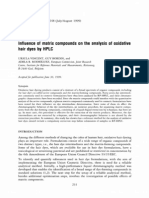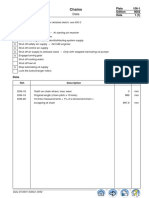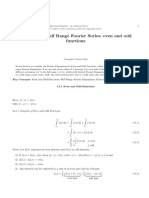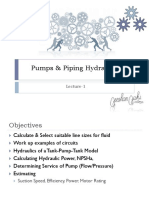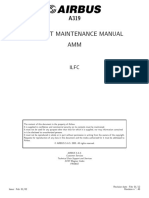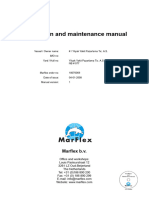Sensors and Instrumentation - Module 3
Uploaded by
manjunathkadla003Sensors and Instrumentation - Module 3
Uploaded by
manjunathkadla003EAST WEST INSTITUTE OF TECHNOLOGY
# 63, Off Magadi Main Road, Bangalore – 560091
DEPARTMENT OF ELECTRONICS AND COMMUNICATION ENGINEERING
III Sem
SENSORS AND INSTRUMENTATION BEC306B
MODULE-3
SENSORS & SIGNAL CONDITIONING
Sensors & Signal Conditioning Module-3
MODULE-3
Principles of Measurement
➢ Static Characteristics
➢ Error in Measurement
➢ Types of Static Error
➢ Multirange Voltmeter
Digital Voltmeter
➢ Ramp Technique
➢ Dual Slope Integrating Type DVM
➢ Direct Compensation type and successive Approximate type DVM
Department of ECE, EWIT 2
Sensors & Signal Conditioning Module-3
PRINCIPLES OF MEASUREMENT
INTRODUCTION
Instrumentation is a technology of measurement which serves not only science but all branches of engineering,
medicine, and almost every human endeavor. The knowledge of any parameter largely depends on the
measurement. The indepth knowledge of any parameter can be easily understood by the use of measurement,
and further modifications can also be obtained.
Measuring is basically used to monitor a process or operation, or as well as the controlling process. For
example, thermometers, barometers, anemometers are used to indicate the environmental conditions.
Similarly, water, gas and electric meters are used to keep track of the quantity of the commodity used, and
also special monitoring equipment are used in hospitals.
Whatever may be the nature of application, intelligent selection and use of measuring equipment depends
on a broad knowledge of what is available and how the performance of the equipment renders itself for the job
to be performed.
But there are some basic measurement techniques and devices that are useful and will continue to be widely
used also. There is always a need for improvement and development of new equipment to solve measurement
problems.
The major problem encountered with any measuring instrument is the error. Therefore, it is obviously
necessary to select the appropriate measuring instrument and measurement method which minimises error.
To avoid errors in any experimental work, careful planning, execution and evaluation of the experiment are
essential.
The basic concern of any measurement is that the measuring instrument should not effect the quantity being
measured; in practice, this non-interference principle is never strictly obeyed. Null measurements with the use
of feedback in an instrument minimise these interference effects.
Department of ECE, EWIT 3
Sensors & Signal Conditioning Module-3
STATIC CHARACTERISTICS
The static characteristics of an instrument are, in general, considered for instruments which are used to
measure an unvarying process condition. All the static performance characteristics are obtained by one form or
another of a process called calibration. There are a number of related definitions (or characteristics), which are
described below, such as accuracy, precision, repeatability, resolution, errors, sensitivity, etc.
1. Instrument: A device or mechanism used to determine the present value of the quantity under
measurement.
2. Measurement: The process of determining the amount, degree, or capacity by comparison (direct or
indirect) with the accepted standards of the system units being used.
3. Accuracy: The degree of exactness (closeness) of a measurement compared to the expected (desired)
value.
4. Resolution: The smallest change in a measured variable to which an instrument will respond.
5. Precision: A measure of the consistency or repeatability of measurements, i.e. successive reading do
not differ. (Precision is the consistency of the instrument output for a given value of input).
6. Expected value: The design value, i.e. the most probable value that calculations indicate one should
expect to measure.
7. Error: T h e deviation of the true value from the desired value.
8. Sensitivity The ratio of the change in output (response) of the instrument to a change of input or
measured variable.
ERROR IN MEASUREMENT
Measurement is the process of comparing an unknown quantity with an accepted standard quantity. It involves
connecting a measuring instrument into the system under consideration and observing the resulting response
on the instrument. The measurement thus obtained is a quantitative measure of the so-called “true value”
(since it is very difficult to define the true value, the term “expected value” is used). Any measurement is
affected by many variables; therefore, the results rarely reflect the expected value. For example, connecting a
measuring instrument into the circuit under consideration always disturbs (changes) the circuit, causing the
measurement to differ from the expected value.
Some factors that affect the measurements are related to the measuring instruments themselves. Other
factors are related to the person using the instrument. The degree to which a measurement nears the expected
value is expressed in terms of the error of measurement.
Error may be expressed either as absolute or as percentage of error.
Absolute error may be defined as the difference between the expected value of the variable and the measured
value of the variable, or
e = Yn – Xn
Department of ECE, EWIT 4
Sensors & Signal Conditioning Module-3
Example 1.1 (a) The expected value of the voltage across a resistor is 80 V. However, the measurement gives
a value of 79 V. Calculate (i) absolute error, (ii) % error, (iii) relative accuracy, and (iv) % of accuracy.
Example 1.1 (b) The expected value of the current through a resistor is 20 mA. However the measurement
yields a current value of 18 mA. Calculate
(i) absolute error (ii) % error (iii) relative accuracy (iv) % accuracy
Solution
Step 1: Absolute error
e = Yn – Xn
where e = error, Yn = expected value, Xn = measured value
Given Yn = 20 mA and Xn = 18 mA
Therefore e = Yn – Xn = 20 mA – 18 mA = 2 A
m
Department of ECE, EWIT 5
Sensors & Signal Conditioning Module-3
If a measurement is accurate, it must also be precise, i.e. Accuracy means precision. However, a precision
measurement may not be accurate. (The precision of a measurement is a quantitative or numerical indication of
the closeness with which a repeated set of measurement of the same variable agree with the average set of
measurements.) Precision can also be expressed mathematically as
where Xn = value of the nth measurement
–
X n = average set of measurement
Example 1.2 Table 1.1 gives the set of 10 measurement that were recorded in the laboratory. Calculate
the precision of the 6th measurement.
Table 1.1
Measurem Measurement
ent value Xn
number
1 98
2 101
3 102
4 97
5 101
6 100
7 103
8 98
9 106
10 99
Department of ECE, EWIT 6
Sensors & Signal Conditioning Module-3
The accuracy and precision of measurements depend not only on the quality of the measuring instrument
but also on the person using it. However, whatever the quality of the instrument and the case exercised by the
user, there is always some error present in the measurement of physical quantities.
TYPES OF STATIC ERROR
The static error of a measuring instrument is the numerical difference between the true value of a quantity and
its value as obtained by measurement, i.e. repeated measurement of the same quantity gives different
indications. Static errors are categorised as gross errors or human errors, systematic errors, and random errors.
Gross Errors
These errors are mainly due to human mistakes in reading or in using instruments or errors in recording
observations. Errors may also occur due to incorrect adjustment of instruments and computational mistakes.
These errors cannot be treated mathematically.
The complete elimination of gross errors is not possible, but one can minimise them. Some errors are easily
detected while others may be elusive.
One of the basic gross errors that occurs frequently is the improper use of an instrument. The error can be
minimized by taking proper care in reading and recording the measurement parameter.
In general, indicating instruments change ambient conditions to some extent when connected into a
complete circuit. (Refer Examples 1.3(a) and (b)).
(One should therefore not be completely dependent on one reading only; at least three separate readings
should be taken, preferably under conditions in which instruments are switched off and on.)
Systematic Errors
These errors occur due to shortcomings of the instrument, such as defective or worn parts, or ageing or effects
of the environment on the instrument.
These errors are sometimes referred to as bias, and they influence all measurements of a quantity alike. A
constant uniform deviation of the operation of an instrument is known as a systematic error. There are basically
three types of systematic errors—(i) Instrumental, (ii) Environmental, and (iii) Observational.
Department of ECE, EWIT 7
Sensors & Signal Conditioning Module-3
(i) Instrumental Errors:
Instrumental errors are inherent in measuring instruments, because of their mechanical structure. For
example, in the D’Arsonval movement, friction in the bearings of various moving components, irregular
spring tensions, stretching of the spring, or reduction in tension due to improper handling or overloading
of the instrument.
Instrumental errors can be avoided by
(a) selecting a suitable instrument for the particular measurement applications. (Refer
Examples 1.3 (a) and (b)).
(b) applying correction factors after determining the amount of instrumental error.
(c) calibrating the instrument against a standard.
(ii) Environmental Errors:
Environmental errors are due to conditions external to the measuring device, including conditions in
the area surrounding the instrument, such as the effects of change in temperature, humidity, barometric
pressure or of magnetic or electrostatic fields.
These errors can also be avoided by (i) air conditioning, (ii) hermetically sealing certain components
in the instruments, and (iii) using magnetic shields.
(iii) Observational Errors:
Observational errors are errors introduced by the observer. The most common error is the parallax
error introduced in reading a meter scale, and the error of estimation when obtaining a reading from
a meter scale.
These errors are caused by the habits of individual observers. For example, an observer may always
introduce an error by consistently holding his head too far to the left while reading a needle and
scale reading.
In general, systematic errors can also be subdivided into static and dynamic errors. Static errors are
caused by limitations of the measuring device or the physical laws governing its behavior. Dynamic
errors are caused by the instrument not responding fast enough to follow the changes in a measured
variable.
Example 1.3 (a) A voltmeter having a sensitivity of 1 is connected across an unknown
resistance in series with a milliammeter reading 80 V on 150 V scale. When the milliammeter reads
10 mA, calculate the (i) Apparent resistance of the unknown resistance, (ii) Actual resistance of the
unknown resistance, and (iii) Error due to the loading effect of the voltmeter.
Department of ECE, EWIT 8
Sensors & Signal Conditioning Module-3
In Example 1.3 (a), a well calibrated voltmeter may give a misleading resistance when connected across
two points in a high resistance circuit. The same voltmeter, when connected in a low resistance circuit
(Example 1.3 (b)) may give a more dependable reading. This show that voltmeters have a loading effect in
the circuit during measurement.
Random Errors
These are errors that remain after gross and systematic errors have been substantially reduced or at least
accounted for. Random errors are generally an accumulation of a large number of small effects and may be of
real concern only in measurements requiring a high degree of accuracy. Such errors can be analyzed
statistically.
These errors are due to unknown causes, not determinable in the ordinary process of making measurements.
Such errors are normally small and follow the laws of probability. Random errors can thus be treated
mathematically.
For example, suppose a voltage is being monitored by a voltmeter which is read at 15 minutes intervals.
Although the instrument operates under ideal environmental conditions and is accurately calibrated before
measurement, it still gives readings that vary slightly over the period of observation. This variation cannot be
corrected by any method of calibration or any other known method of control.
SOURCES OF ERROR
The sources of error, other than the inability of a piece of hardware to provide a true measurement, are as
follows:
1. Insufficient knowledge of process parameters and design conditions
2. Poor design
3. Change in process parameters, irregularities, upsets, etc.
4. Poor maintenance
5. Errors caused by person operating the instrument or equipment
6. Certain design limitations.
Department of ECE, EWIT 9
Sensors & Signal Conditioning Module-3
MULTIRANGE AMMETERS
The current range of the dc ammeter may be further extended by
a number of shunts, selected by a range switch. Such a meter is
called a multirange ammeter, shown in Fig. 3.2.
[
The circuit has four shunts R1, R2, R3 and R4, which can be
placed in parallel with the movement to give four different current
ranges. Switch S is a multiposition switch, (having low contact
resistance and high current carrying capacity, since its contacts
are in series with low resistance shunts). Make before break type
switch is used for range changing. This switch protects the meter
movement from being damaged without a shunt during range
changing.
If we use an ordinary switch for range changing, the meter does not have any shunt in parallel while
the range is being changed, and hence full current passes through the meter movement, damaging the
movement. Hence a make before break type switch is used. The switch is so designed that when the switch
position is changed, it makes contact with the next terminal (range) before breaking contact with the previous
terminal. Therefore, the meter movement is never left unprotected. Multirange ammeters are used for ranges
up to 50A. When using a multirange ammeter, first use the highest current range, then decrease the range until
good upscale reading is obtained. The resistance used for the various ranges are of very high precision values,
hence the cost of the meter increases.
Department of ECE, EWIT 10
Sensors & Signal Conditioning Module-3
Example 3.3 Design a multirange ammeter with range of 0–1 A, 5 A and 10 A employing individual shunt in
each A D’Arsonval movement with an internal resistance of 500 W and a full scale deflection of 10 mA is
available.
Department of ECE, EWIT 11
Sensors & Signal Conditioning Module-3
MULTIRANGE VOLTMETER
As in the case of an ammeter, to obtain a multirange ammeter, a number of shunts are connected across
the movement with a multi-position switch. Similarly, a dc voltmeter can be converted into
a multirange voltmeter by connecting a number of
resistors (multipliers) along with a range switch to
provide a greater number of workable ranges.
Figure 4.2 shows a multirange voltmeter using a
three-position switch and three multipliers R1, R2,
and R3 for voltage values V1, V2, and V3.
Figure 4.2 can be further modified to Fig. 4.3,
which is a more practical arrangement of the
multiplier resistors of a multirange voltmeter.
In this arrangement, the multipliers are connected in a series string, and the range selector selects the
appropriate amount of resistance required in series with the movement.
This arrangement is advantageous compared to the previous one, because all multiplier resistances
except the first have the standard resistance value and are also easily available in precision tolerances.
The first resistor or low range multiplier, R4, is the only special resistor which has to be specially
manufactured to meet the circuit requirements.
Department of ECE, EWIT 12
Sensors & Signal Conditioning Module-3
Example 4.4 A D’ Arsonval movement with a full scale deflection current of 10 mA and internal resistance of
500 W is to be converted into a multirange voltmeter. Determine the value of multiplier required for 0–20 V, 0–
50 V and 0–100 V.
Example 4.5 Convert a basic D’Arsonval movement with an internal resistance of 100 W and a full scale
deflection of 10 mA into a multirange dc voltmeter with ranges from 0 – 5 V, 0 – 50 V and 0 – 100 V.
Department of ECE, EWIT 13
Sensors & Signal Conditioning Module-3
Example 4.6 Convert a basic D’Arsonval movement with an internal resistance of 50 W and a full scale
deflection current of 2 mA into a multirange dc voltmeter with voltage ranges of 0 – 10 V, 0 – 50 V, 0 – 100 V
and 0 – 250
V. Refer to Fig. 4.3.
Department of ECE, EWIT 14
Sensors & Signal Conditioning Module-3
DITITAL VOLTMETERS
RAMP TECHNIQUE
The operating principle i
s to measure the time that a linear ramp takes to change the input level to the ground level, or vice-versa. This
time period is measured with an electronic time-interval counter and the count is displayed as a number of digits
on an indicating tube or display. The operating principle and block diagram of a ramp type DVM are shown in
Figs 5.1 and 5.2.
The ramp may be positive or negative; in this case a negative ramp has been selected.
At the start of the measurement a ramp voltage is initiated (counter is reset to 0 and sampled rate multivibrator
gives a pulse which initiates the ramp generator). The ramp voltage is continuously compared with the voltage
that is being measured. At the instant these two voltage become equal, a coincidence circuit generates a pulse
which opens a gate, i.e. the input comparator generates a start pulse. The ramp continues until the second
comparator circuit senses that the ramp has reached zero value. The ground comparator compares the ramp
with ground. When the ramp voltage equals zero or reaches ground potential, the ground comparator generates
a stop pulse. The output pulse from this comparator closes the gate. The time duration of the gate opening is
proportional to the input voltage value.
In the time interval between the start and stop pulses, the gate opens and the oscillator circuit drives the counter.
The magnitude of the count indicates the
magnitude of the input voltage, which is displayed by the readout. Therefore, the voltage is converted into
time and the time count represents the magnitude of the voltage. The sample rate multivibrator determines the
rate of cycle of measurement. A typical value is 5 measuring cycles per second, with an accuracy of ± 0.005%
of the reading. The sample rate circuit provides an initiating pulse for the ramp generator to start its next ramp
voltage. At the same time a reset pulse is generated, which resets the counter to the zero state.
Any DVM has a fundamental cycle sequence which involves sampling, displaying and reset sequences
Department of ECE, EWIT 15
Sensors & Signal Conditioning Module-3
Advantages and Disadvantages The ramp technique circuit is easy to design and its cost is low. Also, the
output pulse can be transmitted over long feeder lines. However, the single ramp requires excellent characteristics
regarding linearity of the ramp and time measurement. Large errors are possible when noise is superimposed on
the input signal. Input filters are usually required with this type of converter.
DUAL SLOPE INTEGRATING TYPE DVM
In ramp techniques, superimposed noise can cause large errors. In the dual ramp technique, noise is
averaged out by the positive and negative ramps using the process of integration.
Principle of Dual Slope Type DVM As illustrated in Fig. 5.3, the input voltage ‘ei’ is integrated, with
the slope of the integrator output proportional to the test input voltage. After a fixed time, equal to t1, the input
voltage is disconnected and the integrator input is connected to a negative voltage –er. The integrator output will
have a negative slope which is constant and proportional to the magnitude of the input voltage. The block diagram
is given in Fig. 5.4.
Department of ECE, EWIT 16
Sensors & Signal Conditioning Module-3
At the start a pulse resets the counter and the F/F output to logic level ‘0’. Si is closed and Sr is open. The
capacitor begins to charge. As soon as the integrator output exceeds zero, the comparator output voltage
changes state, which opens the gate so that the oscillator clock pulses are fed to the counter. (When the ramp
voltage starts, the comparator goes to state 1, the gate opens and clock pulse drives the counter.) When the
counter reaches maximum count, i.e. the counter is made to run for a time ‘t1’ in this case 9999, on the next
clock pulse all digits go to 0000 and the counter activates the F/F to logic level ‘1’. This activates the switch
drive, ei is disconnected and –er is connected to the integrator. The integrator output will have a negative slope
which is constant, i.e. integrator output now decreases linearly to 0 volts. Comparator output state changes
again and locks the gate. The discharge time t2 is now proportional to the input voltage. The counter indicates
the count during time t2. When the negative slope of the integrator reaches zero, the comparator switches to
state 0 and the gate closes, i.e. the capacitor C is now discharged with a constant slope. As soon as the
comparator input (zero detector) finds that eo is zero, the counter is stopped. The pulses counted by the counter
thus have a direct relation with the input voltage.
i.e. the capacitor C is now discharged with a constant slope. As soon as the comparator input (zero detector)
finds that eo is zero, the counter is stopped. The pulses counted by the counter thus have a direct relation with
the input voltage.
If the oscillator period equals T and the digital counter indicates n1 and n2 counts respectively,
Department of ECE, EWIT 17
Sensors & Signal Conditioning Module-3
From Eq. 5.3 it is evident that the accuracy of the measured voltage is independent of the integrator
time constant. The times t1 and t2 are measured by the count of the clock given by the numbers n1 and n2
respectively. The clock oscillator period equals T and if n1 and er are constants, then Eq. 5.4 indicates that the
accuracy of the method is also independent of the oscillator frequency.
The dual slope technique has excellent noise rejection because noise and superimposed ac are averaged
out in the process of integration. The speed and accuracy are readily varied according to specific requirements;
also, an accuracy of ± 0.05% in 100 ms is available.
DIRECT COMPENSATION TYPE
The input signal is compared with an internally generated voltage which is increased in steps starting from
zero. The number of steps needed to reach the full compensation is counted. A simple compensation type
is the staircase ramp. The Staircase Ramp The basic principle is that the input
input signal Vi is compared with an
internal staircase voltage, Vc, generated by
a series circuit consisting of a pulse
generator (clock), a counter counting the
pulses and a digital to analog converter,
converting the counter output into a dc
signal. As soon as Vc is equal to Vi, the
input comparator closes a gate between the
clock and the counter, the counter stops
and its output is shown on the display. The
basic block diagram is shown in Fig. 5.8.
Operation of the Circuit The clock generates
pulses continuously. At the start of a
measurement, the counter is reset to 0 at time
t1 so that the output of the digital to analog
converter (DAC) is also 0. If Vi is not equal
to zero, the input comparator applies an
output voltage that opens the gate so that
clock pulses are passed on to the counter
through the gate. The counter starts counting
and the DAC starts to produce an output
voltage increasing by one small step at each
count of the counter. The result is a staircase
voltage applied to the second input of the
comparator, as shown in Fig. 5.9
This process continues until the staircase voltage is equal to or slightly greater than the input voltage Vi.
At that instant t2, the output voltage of the input comparator changes state or polarity, so that the gate closes and
the counter is stopped.
Department of ECE, EWIT 18
Sensors & Signal Conditioning Module-3
The display unit shows the result of the count. As each count corresponds to a constant dc step in the DAC
output voltage, the number of counts is directly proportional to Vc and hence to Vi. By appropriate choice of
reference voltage, the step height of the staircase voltage can be determined. For example, each count can
represent 1 mV and direct reading of the input voltage in volts can be realised by placing a decimal point in front
of the 10 decade.
The advantages of a staircase type DVM are as follows:
1. Input impedance of the DAC is high when the compensation is reached.
2. The accuracy depends only on the stability and accuracy of the voltage and DAC. The clock has
no effect on the accuracy.
The disadvantages are the following:
1. The system measures the instantaneous value of the input signal at the moment compensation is reached.
This means the reading is rather unstable, i.e. the input signal is not a pure dc voltage.
2. Until the full compensation is reached, the input impedance is low, which can influence the accuracy.
SUCCESSIVE APPROXIMATIONS TYPE DVM
The successive approximation principle can be easily understood using a simple example; the determination
of the weight of an object. By using a balance and placing the object on one side and an approximate weight
on the other side, the weight of the object is determined.
If the weight placed is more than the unknown weight, the weight is removed and another weight of smaller
value is placed and again the measurement is performed. Now if it is found that the weight placed is less than
that of the object, another weight of smaller value is added to the weight already present, and the measurement
is performed. If it is found to be greater than the unknown weight the added weight is removed and another
weight of smaller value is added. In this manner by adding and removing the appropriate weight, the weight
of the unknown object is determined. The successive approximation DVM works on the same principle. Its
basic block diagram is shown in Fig. 5.10. When the start pulse signal activates the control circuit, the
successive approximation register (SAR) is cleared. The output of the SAR is 00000000. Vout of the D/A
converter is 0. Now, if Vin > Vout the comparator output is positive.
During the first clock pulse, the control circuit sets the D7 to 1, and Vout jumps to the half reference voltage.
The SAR output is 10000000. If Vout is greater than Vin, the comparator output is negative and the control
circuit resets D7. However, if Vin is greater than Vout, the comparator output is positive and the control
circuits keeps D7 set. Similarly, the rest of the bits beginning from D7 to D0 are set and tested. Therefore, the
measurement is completed in 8 clock pulses.
Department of ECE, EWIT 19
Sensors & Signal Conditioning Module-3
At the beginning of the measurement cycle, a start pulse is applied to the start-stop multivibrator. This sets a 1 in
the MSB of the control register and a 0 in all bits (assuming an 8-bit control) its reading would be 10000000.
This initial setting of the register causes the output of the D/A converter to be half the reference voltage, i.e. 1/2
V. This converter output is compared to the unknown input by the comparator. If the input voltage is greater than
the converter reference voltage, the comparator output produces an output that causes the control register to retain
the 1 setting in its MSB and the converter continues to supply its reference output voltage of 1/2 Vref.
The ring counter then advances one count, shifting a 1 in the second MSB of the control register and its
reading becomes 11000000. This causes the D/A converter to increase its reference output by 1 increment to
1/4 V, i.e. 1/2 V + 1/4 V, and again it is compared with the unknown input. If in this case the total reference
voltage exceeds the unknown voltage, the comparator produces an output that causes the control register to
reset its second MSB to 0. The converter output then returns to its previous value of 1/2 V and awaits another
input from the SAR. When the ring counter advances by 1, the third MSB is set to 1 and the converter output
rises by the next increment of 1/2 V + 1/8 V. The measurement cycle thus proceeds through a series of
successive approximations. Finally, when the ring counter reaches its final count, the measurement cycle stops
and the digital output of the control register represents the final approximation of the unknown input voltage.
Example Suppose the converter can measure a maximum of 5 V, i.e. 5 V corresponds to the maximum count of
11111111. If the test voltage Vin = 1 V the following steps will take place in the measurement. (Refer to Table
5.1 and Fig. 5.11.)
Department of ECE, EWIT 20
Sensors & Signal Conditioning Module-3
Therefore, Vin nearly equals Vout, i.e. Vin = 1 V and Vout = 0.99785. The main advantage of this method
is speed. At best it takes n clock pulses to produce an n bit result. Even if the set, test, set or reset operation
takes more than 1 clock pulse, the SAR method is still considerably faster than the counter method. However,
the control circuit is more complex in design and cost is enhanced. This digital voltmeter is capable of 1000
readings per second.
With input voltages greater than dc, the input level
changes during digitisation and decisions made
during conversion are not consistent. To avoid this
error, a sample and hold circuit is used and placed
in the input directly following the input attenuator
and amplifier.
In its simplest form, the sample and hold (S/H)
circuit can be represented by a switch and a
capacitor, as shown in Fig. 5.12.
In the Sample mode, the switch is closed and the
capacitor charges to the instantaneous value of the
input voltage.
In the Hold mode, the switch is opened and the
capacitor holds the voltage that it had at the instant
the switch was opened. If the switch drive is
synchronized with the ring counter pulse, the actual
measurement and conversion takes place when the
S/H circuit is in the Hold mode. The output
waveform of a sample and hold circuit is shown in Fig. 5.13
An actual sample and hold circuit is shown in Fig. 5.14. The sample pulse operates switches 1 and 3. The
hold pulse operates switches 2 and 4. The sample- hold pulses are complementary.
In the sample mode the hold capacitor is charged up by the Opamp. In the hold mode, the capacitor is switched
into the feedback loop, while input resistors R1 and Rf are switched to ground. Opamps are used to increase
the available driving current into the capacitor or to isolate the capacitor from an external load on the output.
The S/H circuit is basically an Opamp that charges the capacitor during the Sample mode and retains the
charge during the Hold mode.
Department of ECE, EWIT 21
You might also like
- Functions and Characteristics of InstrumentsNo ratings yetFunctions and Characteristics of Instruments29 pages
- Emi Discriptive Typeall Units Material.No ratings yetEmi Discriptive Typeall Units Material.123 pages
- Errors Analysis Intro - Types of ErrorsNo ratings yetErrors Analysis Intro - Types of Errors45 pages
- Unit I: Measurement and Measurement SystemsNo ratings yetUnit I: Measurement and Measurement Systems20 pages
- Basic Concepts of Instrumentation and MeasurementNo ratings yetBasic Concepts of Instrumentation and Measurement14 pages
- AP Physics 1 Experimental Uncertainty and Data AnalysisNo ratings yetAP Physics 1 Experimental Uncertainty and Data Analysis20 pages
- KALSI Electronic Instrumentation 3e Chap 01 12 PDFNo ratings yetKALSI Electronic Instrumentation 3e Chap 01 12 PDF405 pages
- Electrical Measurement: Measurement Is The Process by Which One Can Convert Physical ParametersNo ratings yetElectrical Measurement: Measurement Is The Process by Which One Can Convert Physical Parameters16 pages
- Lecture 2&3: Measurement and Functional Elements of InstrumentsNo ratings yetLecture 2&3: Measurement and Functional Elements of Instruments34 pages
- Electrical Measurements and Instrumentation: by Dereje D. Dereder@dtu - Edu.etNo ratings yetElectrical Measurements and Instrumentation: by Dereje D. Dereder@dtu - Edu.et23 pages
- Dr. Mohammed Ammar Department of Electric Power and Machines Cairo UniversityNo ratings yetDr. Mohammed Ammar Department of Electric Power and Machines Cairo University29 pages
- Flarenet Design Basis & Definitions Program By: Program:: Aspen Technology Inc. Aspen Flarenet 2006.5No ratings yetFlarenet Design Basis & Definitions Program By: Program:: Aspen Technology Inc. Aspen Flarenet 2006.52 pages
- Influence of Matrix Compounds On Oxidative Hair Dyes by HPLCNo ratings yetInfluence of Matrix Compounds On Oxidative Hair Dyes by HPLC18 pages
- Silicon Solar Cell Parameters - PVEducationNo ratings yetSilicon Solar Cell Parameters - PVEducation2 pages
- CH 9 Transport in Animals Worksheet 2 Answer KeyNo ratings yetCH 9 Transport in Animals Worksheet 2 Answer Key8 pages
- Backup Online de Valores Actuales s7300No ratings yetBackup Online de Valores Actuales s730011 pages
- OSCAR-III Treatment System O& M And: Troubleshooting Manual January 2019No ratings yetOSCAR-III Treatment System O& M And: Troubleshooting Manual January 201914 pages
- Konstantin Stanislavsky Routledge Performance Practitioners 1st Edition Bella Merlin Latest PDF 2025No ratings yetKonstantin Stanislavsky Routledge Performance Practitioners 1st Edition Bella Merlin Latest PDF 2025175 pages
- Computational Modeling of Nanometer-Scale TribologyNo ratings yetComputational Modeling of Nanometer-Scale Tribology6 pages
- The History of Paper Money in China (Pp. 136-142) John PickeringNo ratings yetThe History of Paper Money in China (Pp. 136-142) John Pickering8 pages
- 6562a589ed1f42b18f8e01b8 MuwitusasevigawifuNo ratings yet6562a589ed1f42b18f8e01b8 Muwitusasevigawifu2 pages
- Product Specifications Product Specifications: Ldf4Rn LDF4RN - 50A 50ANo ratings yetProduct Specifications Product Specifications: Ldf4Rn LDF4RN - 50A 50A3 pages
- Engineering Specification For MV SwitchgearNo ratings yetEngineering Specification For MV Switchgear21 pages
- Lecture 14: Half Range Fourier Series: Even and Odd FunctionsNo ratings yetLecture 14: Half Range Fourier Series: Even and Odd Functions5 pages
- Loctite Solvo-Rust Super Penetrating Oil AerosolNo ratings yetLoctite Solvo-Rust Super Penetrating Oil Aerosol4 pages








